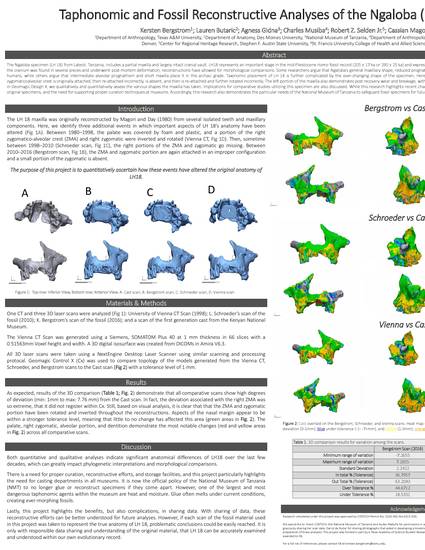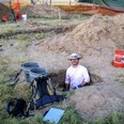
Presentation
Taphonomic and Fossil Reconstructive Analyses of the Ngaloba (LH 18) Skull
Presented at the 2018 American Association of Physical Anthropologists meeting in Austin, Texas
(2018)
Abstract
The Ngaloba specimen (LH 18) from Laetoli, Tanzania, includes a partial maxilla and largely intact cranial vault. LH 18 represents an important stage in the mid-Pleistocene Homo fossil record (205 ± 17 ka or 290 ± 25 ka) and expresses several primitive and derived craniofacial features. Although the cranium was found in several pieces and underwent post-mortem deformation, reconstructions have allowed for morphological comparisons. Some researchers argue that Ngaloba's general maxillary shape, reduced prognathism, and reduced robusticity align the specimen with modern humans, while others argue that the intermediate alveolar prognathism and short maxilla place it in the archaic grade. Taxonomic placement of LH 18 is further complicated by the ever-changing shape of the specimen. Here, we demonstrate four events in which a portion of the right zygomaticoalveolar crest is originally attached, then re-attached incorrectly, is absent, and then is re-attached and further rotated incorrectly. The left portion of the maxilla also demonstrates post recovery wear and breakage, with palate expansion. Through an analysis of 3D surface and CT scans in Geomagic Design X and Geomagic Control X, we qualitatively and quantitatively assess the various shapes the maxilla has taken. Implications for comparative studies utilizing this specimen are also discussed. While this research highlights recent changes in LH 18, it also demonstrates the importance of scanning original specimens, and the need for supporting proper curation techniques at museums. Accordingly, this research also demonstrates the particular needs of the National Museum of Tanzania to safeguard fossil specimens for future research.
Keywords
- africa,
- tanzania,
- laetoli,
- Ngaloba,
- LH18,
- computer-aided inspection
Publication Date
2018
Citation Information
Kersten Bergstrom, Lauren Butaric, Agness O Gidna, Charles Musiba, et al.. "Taphonomic and Fossil Reconstructive Analyses of the Ngaloba (LH 18) Skull" Presented at the 2018 American Association of Physical Anthropologists meeting in Austin, Texas (2018) Available at: http://works.bepress.com/zac_selden/217/
Creative Commons License

This work is licensed under a Creative Commons CC_BY-NC-ND International License.
